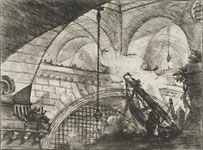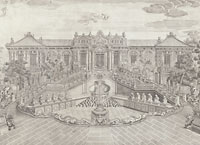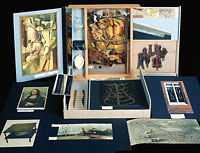Remarkable Repositories: Assembling the Getty
Allen assumed her position eighteen months after the new building was opened in 1997. “When I first arrived here, it was empty,” she said, and by that she meant empty of readers, not materials. “Up until that time, for fifteen years or so, all the books and research materials that were being acquired were kept in a bank building in Santa Monica, and there were only seats for twelve readers there, so it really couldn’t be opened to the public. It couldn’t even be opened to scholars. Since then, we’ve let everyone know we’re here—and we’re now getting about five thousand readers a year in to use our materials.”
Hired in 1983 from the University of Missouri-Columbia, Marcia Reed has been involved in collection development from the beginning. A number of approaches were used, she told me, including the purchase of scholar’s libraries assembled by noted professors and bibliographers. “We had the money, and we could pretty much buy what we wanted,” she said. “Within a matter of weeks of my getting here, we were acquiring large collections of rare books. I was unpacking them and checking them in, and feeling like I’d died and gone to heaven. This was in July, August, September 1983—right off the bat.”
In order to attract scholars from around the world, needless to say, much more than books are necessary, and the Getty has been keen to purchase archives, manuscripts, maps, prints, drawings, sketchbooks, and rare photographs as well. Acquisitions have come from a variety of sources, privately from individuals, at auction, and from dealers, whose knowledge, Reed said, has been particularly helpful. “It didn’t take them very long to realize that there was a major library being built here, and they wanted to be a part of what we were doing.”
Rare books Reed is especially pleased to have acquired for the Getty include Luca Pacioli’s Divina Proportione (Venice, 1509), with designs for letters by Leonardo da Vinci, and Geoffroy Tory’s Champfleury (Paris, 1529) on the just shaping of letters. A large collection of books and prints on the ephemeral art of Italian festivals includes a hand-painted scroll depicting the coronation of Charles V by Clement VIII, engraved by Nikolaus Hogenberg (Bologna, 1530). An early acquisition was a complete collection of the etchings and illustrated books of the Italian artist Giovanni Battista (Giambattista) Piranessi (1720 - 1778). The twentieth-century collections of publications and multiples by avant-garde artists include books by Russian and Italian Futurists, German Expressionists, and books and boxes by Dada-Surrealist artist Marcel Duchamp.
In 2007, the GRI mounted an exhibition called China on Paper: European and Chinese Works From the Late Sixteenth to the Early Nineteenth Century, and published a catalog of the same title co-edited by Reed with art scholar Paolo Demattè. The show featured illustrated travel books, religious and philosophical texts, scientific and literary treatises, maps, and a suite of spectacular eighteenth-century prints of the old summer palace outside of Beijing, known as the Yuan Ming Yuan, and credited to Yi Lantai, a Manchu who received his training from Jesuit court artists, and the first copper-plate engravings to be produced in China by local artists. The engravings were purchased by Reed for the institute from a rare book dealer in 1989.
At the time of the acquisition, the library’s collections were focused on the traditional categories of Western art history, but as so often happens when serendipity is in play, new vistas were opened, almost immediately. “These engravings,” Reed wrote in the catalog, “inaugurated the Research Library’s collections documenting East-West contacts, an acquisitions initiative that has resulted in significant holdings on Asia, including early photographs of China, Japanese artwork of the post World War Two era, and the diverse works featured in China on Paper.”
Reed explained for me her involvement in the project as curator as an instance, basically, of one thing leading to another. “Once I acquired these materials for the institute, I got really interested in them myself, and I started to read about the Jesuit missionaries in China. There were never very many of them there—at most twenty-three maintaining the mission, along with lay brothers—but there were all sorts of creative people, astronomers, mathematicians, mapmakers, you name it, all of them gathering this information and producing these amazing books and prints about China, all of it on paper, all of it going back to Europe—and crucial to the exchange of ideas between East and West.”
The nature of this sort of endeavor, Reed said, finally—which is the joy, after all, of working in a great library—is that “it’s endless.”












 Nicholas A. Basbanes recently received a National Endowment for the Humanities fellowship to work on his book on paper, which is forthcoming from Knopf. His most recent book is Editions & Impressions, a collection of essays. His other works include the acclaimed A Gentle Madness, Every Book Its Reader, Patience & Fortitude, Among the Gently Mad, and A Splendor of Letters.
Nicholas A. Basbanes recently received a National Endowment for the Humanities fellowship to work on his book on paper, which is forthcoming from Knopf. His most recent book is Editions & Impressions, a collection of essays. His other works include the acclaimed A Gentle Madness, Every Book Its Reader, Patience & Fortitude, Among the Gently Mad, and A Splendor of Letters.